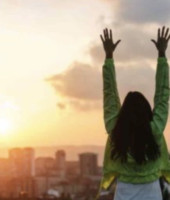I have long been the sort of person whose self-worth was primarily determined by her productivity. In fact, I have spent so much time in a flurry of activity, a “human doing,” that I rarely took the time to be a “human being.”
This March, when the world came to a screeching halt, this solo dweller resolved, like many of her contemporaries, to “be more present.” But what does that even mean? Like many an often used phrase, it has lost much of its meaning. For me, presence means cultivating safe spaces for myself and for others. It means using my voice and listening to my body. It means establishing and maintaining spaces, personal and professional, virtual and physical, where others and myself feel seen, heard and cared for.
Cultivating Community
For many, the pandemic has brought us into closer contact with our neighbors than ever before. But living in close proximity is no assurance of connection. At its best neighbor is a verb!
For guidance on the lost art of neighboring look no further than my favorite neighbor Mr. Rogers. There are countless purely humanist ways to be a good neighbor. To quote Rogers “look for the helpers” and resolve to be one of them. In any crisis there’s always someone helping. Be alert to observe random acts of kindness and practice gratitude. Why not tell a healthcare hero thank you and, if you can, do it with a meal. If like Rogers, you are person of faith, pray for others and ask them to pray for you. It’s a supreme expression of neighborliness and it dignifies others.
Throughout the pandemic I’ve looked after the elderly widow who lives next door. Receiving her packages, buying her groceries and just making myself available for socially distanced chats. The bachelor upstairs recently stopped by to introduce himself with a bottle of wine, another show of kindness. A simple greeting can light up the darkness for someone coping with isolation and depression.
Take Up Space and Use Your Voice
A space isn’t safe if you’re shrinking. Let me repeat that, a space isn’t safe if you’re shrinking. Don’t reduce yourself to make others feel at ease. Take a deep breath. Let it out slowly. Now expand!
We’re all sometimes hesitant to express our feelings but the secret to creating spaces that are joyful and safe for everyone is to use your voice. Don’t suppress your ideas and insights and don’t hold back from correcting toxic behaviors.
Determine that your workplace, your home, your club, wherever you have a sphere of influence, will be a place where no one is bullied and/or belittled. Be actively anti-racist and don’t be afraid to clap back at micro-aggressions. By doing so, you’re creating more equitable spaces for the women who come after you.
Pre-pandemic, I attended a lecture and the grand opening of a center for history. Although I’ve worked in higher ed for 10 years, as a marketer and writer, I’m not always at ease with academic discourse. I noticed that none of the brown people in the room were speaking. So I asked the historian presenting, who is also a fashion blogger, what she had learned from engaging with history both on social media and in academia. She said, “I learned that intellectual authority should never be based on how you look.”
That question and her response democratized the discussion. Children started asking questions, so did mothers and minorities. And post-event the cocktail party was lit. Colleagues from Jewish Studies approached me to thank me and share their experiences with gender discrimination. My point is you add value wherever you go and by seizing your power you will empower others so take up space and use your voice.
Listen
Try not to invalidate other people’s experiences. Listen. That’s it, just listen. Give others the benefit of your time and attention. Most people listen to formulate a response. At its best, the art of listening is an active and engaged way to pursue understanding. Listen to gain insight and as an expression of compassion.
While you’re at it, don’t forget to practice self-compassion and listen to yourself. Practice mindfulness and journaling. Notice shifts in your internal monologue. Listen to your body, practicing intuitive eating and exercise. Movement is a gift, a celebration of life. Do it every day. Show love and appreciation to and for your body by nourishing it with colorful, flavorful, nutrient dense foods.
Maintain healthy boundaries and practice meaningful self -care. Celebrate small victories. For me this meant that for working out every day for a month and publishing an article I rewarded myself with a face mask and mimosas. I will always be my friends biggest cheerleader but I will also never forget to clap for myself.
Nurture Something
I’ve grown by growing things. Pre-pandemic, I was a prolific plant serial killer. Nowadays filling my home with vibrant shades of green brings me so much joy.
Watering my plants each day is the most mindful activity I regularly engage in. I never feel more present than when I am caring for my plants and watching them grow. By creating a space where living things are free to flourish, I’ve enhanced that space and made it more of a home.
Outside is Not Closed!
We’ve grown fond of saying “outside is closed” but the great outdoors are very much open. Try visiting a national park, if you have one in your area. Do some exploring in your neighborhood.
Many of my favorite activities are among the few recreational options currently available. I’ve never enjoyed hiking, kayaking, paddle boarding or picnicking so much as during the pandemic. It’s also a good time to go camping or glamping, even if it’s in your own backyard.
Watch the sunrise on the beach, be an awed spectator to a starry night or a few fireflies. Above all be present and be kind. As you continue to spread rather than stifle your light, you’ll cast a warm glow over all who surround you. Here’s to safe spaces and wide-open doors.





